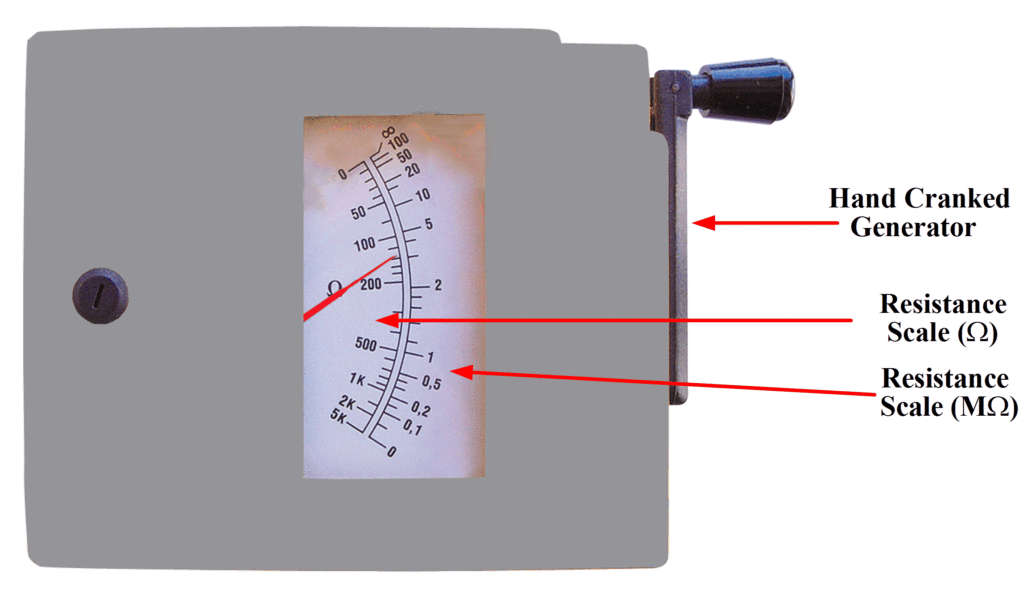The article explains the function and applications of a megohmmeter, an instrument used to measure high resistances, particularly insulation resistance in electrical cables and components. It covers how megohmmeters work, including hand-cranked and battery-powered types, and describes their use in detecting insulation failures in motors and transformers.
What is a Megohmmeter?
The megohmmeter (or megger) is an instrument for measuring very high resistances, such as the insulation resistance of electrical cables.
A high voltage source is required to pass a measurable current through such resistances. Thus, the megger is essentially an ohmmeter with a sensitive deflection instrument and a high voltage source. As illustrated in Figure 1, the voltage is usually produced by a hand-cranked generator. The generated voltage may range from 100 V to 2.5 kV.
Figure 1. Hand-Cranked Megohmmeter Labeled Diagram
As in the case of a low resistance ohmmeter, the scale of the megger indicates infinity (∞) when measuring an open-circuit, zero on a short-circuit, and half-scale when the unknown resistance equals a standard resistor inside the megohmmeter. At other points on the scale, the deflection is proportional to the ratio of the unknown and standard resistors. The range of the instrument can be altered by switching different values of the standard resistor into the circuit.
Battery powered Megohmmeters are also available, and these are essentially very high resistance ohmmeters. The battery voltage is typically increased (by electronic circuitry) to a level of 1000V in order to produce a measurable current through the unknown resistance. The measurement is made when the power button is pressed and hold briefly. This action minimizes the drain current on the battery.
Applications of Megohmmeter
A Megohmmeter is also used to detect insulation failure within motors and transformers. This is achieved by inducing high voltages into the windings of these electrical components. The introduction of a large amount of voltage will result in the detection of weakened insulation; most likely will lead to motor failure or transformer short-circuiting. The voltages used in Megger insulation testing can range from 50 V to 5000 V. By inducing a high voltage into the windings of a motor or transformer, you will be able to detect if there is insulation deterioration. If so, the current will flow out of the windings. Escaping current can possibly result in a ground fault or a short-circuiting of the motor or transformer windings.
Megohmmeter Circuit Diagram
Figure 3 shows the detailed circuit diagram of Megohmmeter.
Figure 3. Megohmmeter Circuit Diagram
1 and 2: Control and Deflecting Coil
They are typically mounted to each other at an angle of 90 degrees and linked to the generator in a parallel manner. The polarities are in such a way that the torque developed by these coils is in the opposite direction.
3 and 4: Scale and Pointer
A pointer is tied to the coils and end of the pointer moves on a meter scale having a range between “zero” and “infinity”. The scale is calibrated in “ohms”.
5 and 6: Pressure Coil and Current Coil resistances
They provide protection against any damage in case of low external resistance under test.
7: D.C generator or battery connection
In manually operated megger, a DC generator provides test voltage while in digital type megger, this is done by battery or voltage charger.
8: Permanent Magnets
Permanent magnets generate a magnetizing effect in order to deflect the pointer.
How to use a Megohmmeter
- Isolate the equipment to be tested from all power circuits
- Connect leads to the appropriate terminals for insulation testing
- Set the function switch to the desired voltage the meter will induce into the electrical component
Note: It is important to check with the manufacturer about performing insulation testing and ratings of the electrical component before proceeding. Too much voltage can void the warranty, shorten the life, or cause damage to the motor or transformer being tested.
- Connect tips of the test leads to the equipment to be tested. If there is a voltage present most meters will give some type of warning.
- Follow the equipment manual and begin the test.
When testing between the windings and earth ground the result should be zero resistance. If there is some type of resistance between the windings and earth ground, the result will be a ground fault at this point and it is important to replace the unit.
When testing between two separate windings the result should be close to zero. If there is some type of resistance between the two separate windings this is an indication that the insulation is breaking down at this point and is important to plan for the equipment to be replaced.
Megohmmeter Key Takeaways
Understanding and utilizing megohmmeters is crucial for maintaining the safety and reliability of electrical systems. These instruments are essential for detecting insulation failures in cables, motors, and transformers, which can prevent costly repairs and potential hazards. By providing precise measurements of high resistances, megohmmeters help ensure the proper functioning and longevity of electrical components, making them invaluable tools in both industrial and residential applications.

